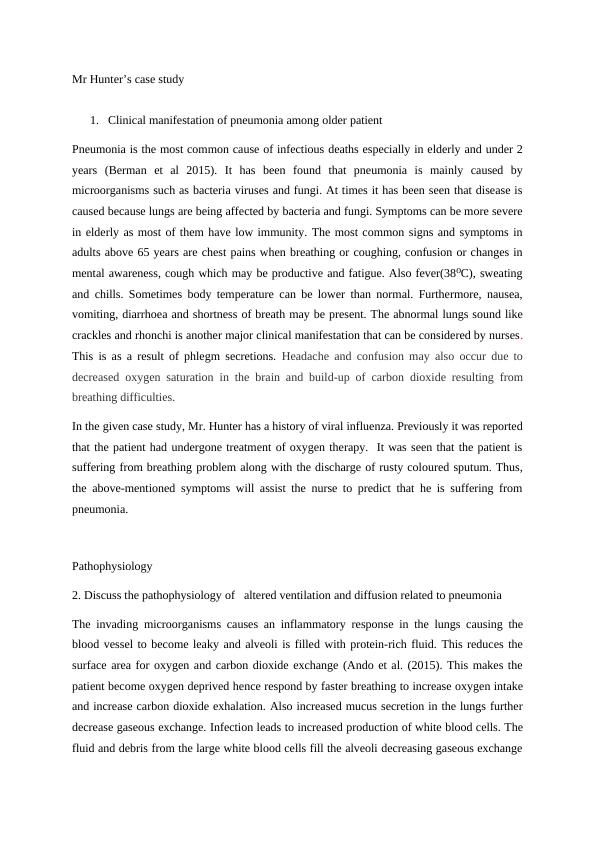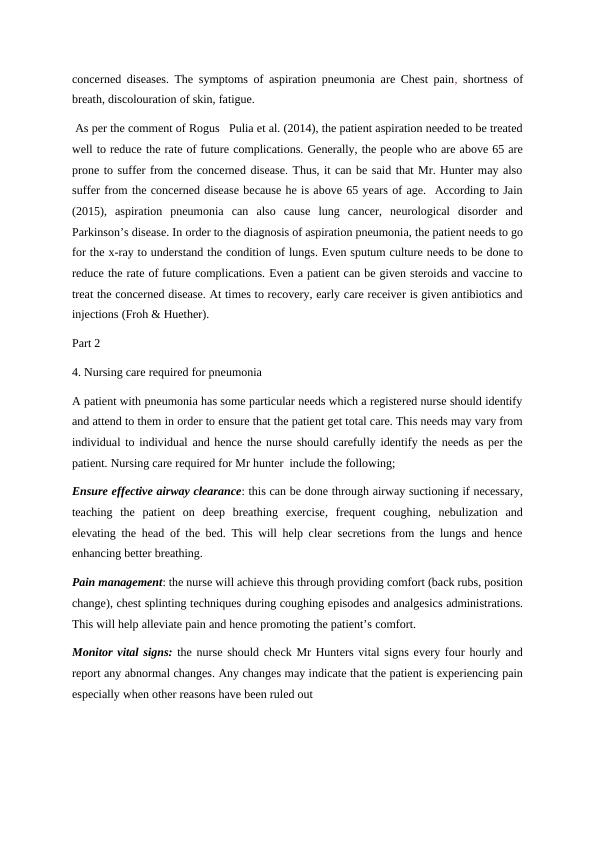Ask a question from expert
Nursing Case Study - Clinical manifestation of pneumonia among older patient
11 Pages3699 Words64 Views
Added on 2021-05-31
Nursing Case Study - Clinical manifestation of pneumonia among older patient
Added on 2021-05-31
BookmarkShareRelated Documents
NursingStudent’s name:Institutional:

Mr Hunter’s case study1.Clinical manifestation of pneumonia among older patientPneumonia is the most common cause of infectious deaths especially in elderly and under 2years (Berman et al 2015). It has been found that pneumonia is mainly caused bymicroorganisms such as bacteria viruses and fungi. At times it has been seen that disease iscaused because lungs are being affected by bacteria and fungi. Symptoms can be more severein elderly as most of them have low immunity. The most common signs and symptoms inadults above 65 years are chest pains when breathing or coughing, confusion or changes inmental awareness, cough which may be productive and fatigue. Also fever(38 C), sweating⁰and chills. Sometimes body temperature can be lower than normal. Furthermore, nausea,vomiting, diarrhoea and shortness of breath may be present. The abnormal lungs sound likecrackles and rhonchi is another major clinical manifestation that can be considered by nurses.This is as a result of phlegm secretions. Headache and confusion may also occur due todecreased oxygen saturation in the brain and build-up of carbon dioxide resulting frombreathing difficulties.In the given case study, Mr. Hunter has a history of viral influenza. Previously it was reportedthat the patient had undergone treatment of oxygen therapy. It was seen that the patient issuffering from breathing problem along with the discharge of rusty coloured sputum. Thus,the above-mentioned symptoms will assist the nurse to predict that he is suffering frompneumonia.Pathophysiology2. Discuss the pathophysiology of altered ventilation and diffusion related to pneumoniaThe invading microorganisms causes an inflammatory response in the lungs causing theblood vessel to become leaky and alveoli is filled with protein-rich fluid. This reduces thesurface area for oxygen and carbon dioxide exchange (Ando et al. (2015). This makes thepatient become oxygen deprived hence respond by faster breathing to increase oxygen intakeand increase carbon dioxide exhalation. Also increased mucus secretion in the lungs furtherdecrease gaseous exchange. Infection leads to increased production of white blood cells. Thefluid and debris from the large white blood cells fill the alveoli decreasing gaseous exchange

ad ventilation. Consolidation occurs when the normally hollow air filled spaces(alveoli)solidify due to large quantities of fluid and debris. This usually a feature of bacterialpneumonias. Viral and mycoplasma not result in consolidation. In the given case Mr Hunteris predicted with pneumonia because the individual is suffering from constant breathlessnessand cough. It has been mentioned that Mr Hunter has already taken oxygen therapy toincrease the flow of oxygen. Even Hudson masks were used to stabilise the condition. In thestudy, it has been mentioned that the nurse understood that Mr Hunter was suffering fromPneumonia is a severe disease that targets lungs resulting in effects on alveoli. Some of thesignificant sources of are bacteria and viruses. Primary infections are also caused by normalflora and inhalation of microbes. Process information 3. Difference between hospital, community and aspiration pneumoniaAs per the viewpoint of Méndez et al. (2014), community-acquired pneumonia occurs outsidehealthcare facilities. It is may be caused by bacteria (streptococcus pneumonia), bacteria likeorganisms (mycoplasma pneumoniae), fungi and viruses(influenza). The symptoms ofcommunity-acquired pneumonia are fever, sputum production, cough. The concerned diseasecan be diagnosed by creating x-ray. It can be said that the concerned disease can be cured byproviding antibiotics.Contrary to this hospital-based pneumonia can be caused in any age group. The concerneddisease is caused to an individual after coming in contact with the hospitalized patients. Asper the comment of Rogus‐Pulia et al. (2014), an individual who spends more than 72 hoursin a hospital can suffer from hospital-acquired pneumonia because of the hospital-basedorganisms. This can be more serious as bacteria causing the pneumonia may be resistant toantibiotics. Also the people who get are already sick. People on ventilators are at higher riskof getting this type of pneumonia. The symptoms of hospital-acquired pneumonia are urinarytract infection, high fever, cough, decreased blood pressure. In addition to this, it has beenobserved that a patient suffering from hospital-acquired pneumonia can be treated byproviding antibiotic to them.Aspiration pneumonia on the other hand is caused by pulmonary aspiration. Pulmonarypneumonia is caused when an individual inhale, food, stomach acid and saliva in lungs.Generally, it has been seen that the mentioned materials carry bacteria in lungs causing the

concerned diseases. The symptoms of aspiration pneumonia are Chest pain, shortness ofbreath, discolouration of skin, fatigue. As per the comment of Rogus‐Pulia et al. (2014), the patient aspiration needed to be treatedwell to reduce the rate of future complications. Generally, the people who are above 65 areprone to suffer from the concerned disease. Thus, it can be said that Mr. Hunter may alsosuffer from the concerned disease because he is above 65 years of age. According to Jain(2015), aspiration pneumonia can also cause lung cancer, neurological disorder andParkinson’s disease. In order to the diagnosis of aspiration pneumonia, the patient needs to gofor the x-ray to understand the condition of lungs. Even sputum culture needs to be done toreduce the rate of future complications. Even a patient can be given steroids and vaccine totreat the concerned disease. At times to recovery, early care receiver is given antibiotics andinjections (Froh & Huether).Part 24. Nursing care required for pneumonia A patient with pneumonia has some particular needs which a registered nurse should identifyand attend to them in order to ensure that the patient get total care. This needs may vary fromindividual to individual and hence the nurse should carefully identify the needs as per thepatient. Nursing care required for Mr hunter include the following;Ensure effective airway clearance: this can be done through airway suctioning if necessary,teaching the patient on deep breathing exercise, frequent coughing, nebulization andelevating the head of the bed. This will help clear secretions from the lungs and henceenhancing better breathing. Pain management: the nurse will achieve this through providing comfort (back rubs, positionchange), chest splinting techniques during coughing episodes and analgesics administrations.This will help alleviate pain and hence promoting the patient’s comfort.Monitor vital signs: the nurse should check Mr Hunters vital signs every four hourly andreport any abnormal changes. Any changes may indicate that the patient is experiencing painespecially when other reasons have been ruled out

End of preview
Want to access all the pages? Upload your documents or become a member.
Related Documents
Pneumonia: Causes, Pathophysiology, Symptoms, and Treatment Optionslg...
|8
|1716
|315
Shortness of Breath | Case Studylg...
|2
|659
|15
Acute Respiratory Distress Syndrome (ARDS) - Pathophysiology, Management, and pH Changeslg...
|4
|788
|89
Pathophysiology and Patient Scenario | Case Studylg...
|11
|2905
|78
Pathophysiology and Pharmacologylg...
|12
|3402
|359
Nursing Care Plan and Interventionlg...
|9
|2911
|48